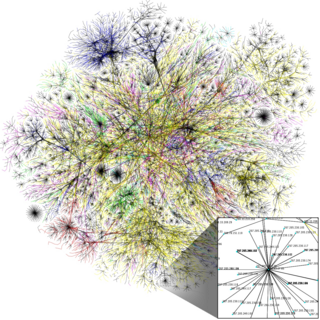The reputation or prestige of a social entity is an opinion about that entity - typically developed as a result of social evaluation on a set of criteria, such as behavior or performance.

Anthony Giddens, Baron Giddens is an English sociologist who is known for his theory of structuration and his holistic view of modern societies. He is considered to be one of the most prominent modern sociologists and is the author of at least 34 books, published in at least 29 languages, issuing on average more than one book every year. In 2007, Giddens was listed as the fifth most-referenced author of books in the humanities. He has academic appointments in approximately twenty different universities throughout the world and has received numerous honorary degrees.

Internet culture is a quasi-underground culture developed and maintained among frequent and active users of the Internet who primarily communicate with one another online as members of online communities; that is, a culture whose influence is "mediated by computer screens" and Information Communication Technology, specifically the Internet.

Daum is a South Korean web portal. It offers many Internet services to web users, including a popular free web-based e-mail, messaging service, forums, shopping, news and webtoon service. The word "daum" means "next" and also "diverse voices".
Digital identity refers to the information utilized by computer systems to represent external entities, including a person, organization, application, or device. It encompasses a person's compiled information and plays a crucial role in automating access to computer-based services, verifying identity online, and enabling computers to mediate relationships between entities. Digital identity is an aspect of a person's social identity and can also be referred to as online identity.
Personalization consists of tailoring a service or a product to accommodate specific individuals, sometimes tied to groups or segments of individuals. A wide variety of organizations use personalization to improve customer satisfaction, digital sales conversion, marketing results, branding, and improved website metrics as well as for advertising. Personalization is a key element in social media and recommender systems. Personalization is affecting every sector of society—work, leisure, and citizenship.

Identity document forgery is the process by which identity documents issued by governing bodies are copied and/or modified by persons not authorized to create such documents or engage in such modifications, for the purpose of deceiving those who would view the documents about the identity or status of the bearer. The term also encompasses the activity of acquiring identity documents from legitimate bodies by falsifying the required supporting documentation in order to create the desired identity.
Hyperlocal is information oriented around a well-defined community with its primary focus directed toward the concerns of the population in that community. The term can be used as a noun in isolation or as a modifier of some other term. When used in isolation it refers to the emergent ecology of data, aggregators, publication mechanism and user interactions and behaviors which centre on a resident of a location and the business of being a resident. More recently, the term hyperlocal has become synonymous with the combined use of applications on mobile devices and GPS technology. Use of the term originated in 1991, in reference to local television news content.
Internet identity (IID), also online identity, online personality or internet persona, is a social identity that an Internet user establishes in online communities and websites. It may also be an actively constructed presentation of oneself. Although some people choose to use their real names online, some Internet users prefer to be anonymous, identifying themselves by means of pseudonyms, which reveal varying amounts of personally identifiable information. An online identity may even be determined by a user's relationship to a certain social group they are a part of online. Some can be deceptive about their identity.

Personal web pages are World Wide Web pages created by an individual to contain content of a personal nature rather than content pertaining to a company, organization or institution. Personal web pages are primarily used for informative or entertainment purposes but can also be used for personal career marketing, social networking with other people with shared interests, or as a space for personal expression.
Personal branding is the conscious and intentional effort to create and influence public perception of an individual by positioning them as an authority in their industry, elevating their credibility, and differentiating themselves from the competition, to ultimately advance their career, widen their circle of influence, and have a larger impact.

Digital marketing is the component of marketing that uses the Internet and online-based digital technologies such as desktop computers, mobile phones and other digital media and platforms to promote products and services. Its development during the 1990s and 2000s changed the way brands and businesses use technology for marketing. As digital platforms became increasingly incorporated into marketing plans and everyday life, and as people increasingly used digital devices instead of visiting physical shops, digital marketing campaigns have become prevalent, employing combinations of search engine optimization (SEO), search engine marketing (SEM), content marketing, influencer marketing, content automation, campaign marketing, data-driven marketing, e-commerce marketing, social media marketing, social media optimization, e-mail direct marketing, display advertising, e-books, and optical disks and games have become commonplace. Digital marketing extends to non-Internet channels that provide digital media, such as television, mobile phones, callbacks, and on-hold mobile ring tones. The extension to non-Internet channels differentiates digital marketing from online marketing.
Content creation is the act of producing and sharing information or media content for specific audiences, particularly in digital contexts. According to Dictionary.com, content refers to "something that is to be expressed through some medium, as speech, writing or any of various arts" for self-expression, distribution, marketing and/or publication. Content creation encompasses various activities including maintaining and updating web sites, blogging, article writing, photography, videography, online commentary, social media accounts, and editing and distribution of digital media. In a survey conducted by Pew, content creation was defined as "the material people contribute to the online world."
Identity tourism may refer to the act of assuming a racial, ethnic, socioeconomic, sexual or gender identity for recreational purposes, or the construction of cultural identities and re-examination of one’s ethnic and cultural heritage from what tourism offers its patrons.

Digital footprint or digital shadow refers to one's unique set of traceable digital activities, actions, contributions, and communications manifested on the Internet or digital devices. Digital footprints can be classified as either passive or active. The former is composed of a user's web-browsing activity and information stored as cookies. The latter is often released deliberately by a user to share information on websites or social media. While the term usually applies to a person, a digital footprint can also refer to a business, organization or corporation.

Customer experience, sometimes abbreviated to CX, is the totality of cognitive, affective, sensory, and behavioral consumer responses during all stages of the consumption process including pre-purchase, consumption, and post-purchase stages. Nihat Tavşan and Can Erdem bring an extensive elucidation to the customer experience, encompassing the dimensions of consciousness, subjectivity, and interactional nature and define customer experience as the sum of subjective ideas regarding a product or service that occur at a conscious or subconscious level due to direct or indirect interaction of a customer with brand-related stimuli. Pine and Gilmore described the experience economy as the next level after commodities, goods, and services with memorable events as the final business product. Four realms of experience include esthetic, escapist, entertainment, and educational components. Tavşan and Erdem divided the customer experience into four categories based on the levels of cognitive and physical involvement of customers. These four categories are euphoric experiences, captive experiences, mellowing experiences, and conductive experiences.
Hub Culture is an invitation-led social network service that operates its own digital currency, Ven. Hub Culture is located in Bermuda. Founded in 2002, it claims it had 32,000 members by 2021 - based on registered accounts.
Online presence management is the process of creating and promoting traffic to a personal or professional brand online. This process combines web design, and development, blogging, search engine optimization, pay-per-click marketing, reputation management, directory listings, social media, link sharing, and other avenues to create a long-term positive presence for a person, organization, or product in search engines and on the web in general.
Digital identity is used in Australia by residents to validate who they are over digital media, such as over the Internet.

Self-sovereign identity (SSI) is an approach to digital identity that gives individuals control over the information they use to prove who they are to websites, services, and applications across the web. Without SSI, individuals with persistent accounts (identities) across the internet must rely on a number of large identity providers, such as Facebook and Google, that have control of the information associated with their identity. If a user chooses not to use a large identity provider, then they have to create new accounts with each service provider, which fragments their web experiences. Self-sovereign identity offers a way to avoid these two undesirable alternatives. In a self-sovereign identity system, the user accesses services in a streamlined and secure manner, while maintaining control over the information associated with their identity.








